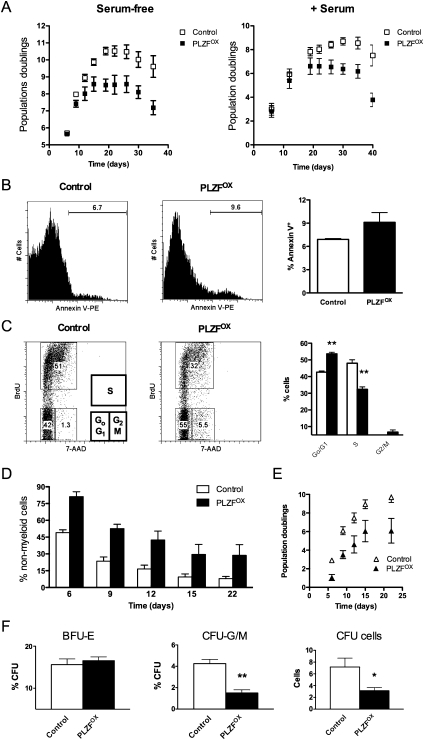Figure 2.
PLZF restricts myeloid proliferation and differentiation of human progenitors in vitro. (A) Effect of PLZF on progenitor proliferation. Growth of CD34+ progenitors transduced with MPG (control) or MPG-PLZF (PLZFOX) vectors in serum-free and serum-supplemented cultures quantified by total cell counting. (B) Effect of PLZF on apoptosis. Proportion of annexin V+ (7AAD−) apoptotic cells after 7 d in serum-supplemented cultures initiated with control or PLZFOX CD34+ cells; the difference between groups is not significant. (C) Effect of PLZF on cell cycle kinetics. BrdU incorporation of control and PLZFOX CD34+ cells cultured for 7 d in serum-free conditions; representative flow cytometric profiles (left panel) and the proportion of cells in G0/G1, S, and G2/M phases of the cell cycle (right panel) are shown. (D) Effect of PLZF on myeloid differentiation. Proportion of nonmyeloid (CD15− CD14− CD11b−) cells in serum-free cultures initiated with control or PLZFOX CD34+ cells. (E) Production of mature lineage-positive myeloid cells in serum-free cultures initiated with sorted control or PLZFOX CD34+ cells. (F) Effect of PLZF on clonogenic progenitors. Colony-forming capacity (colonies counted as proportion of input; percentage of CFU) of freshly sorted control or PLZFOX CD34+ cells. (BFU-E) Erythroid blast-forming units; (CFU-G/M) granulocyte or monocyte colony-forming units; (CFU cells) total myeloid cells × 105 in a CFU-G/M assay. All data are expressed as mean ± SEM of three independent experiments (CB samples), except F, which has four experiments. (*) P < 0.05; (**) P < 0.005.

